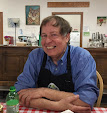Breaking the pinata
Shannon never took history for granted. She's the daughter who always was
asking questions about missing people and parts in the stories she heard.
What if one of the wise men was actually a woman? Couldn't Minnehaha have carried Hiawatha across the creek instead of the other way around? Those are just a few of the questions I remember her asking as she was growing
up.
I was thinking of Shannon's questions the other day during a discussion about
teaching history. One model is based is based on the idea that history is the
story of wars. According to this view, history is a series of great big guys who
win battles and topple civilizations. That's certainly one view.
But it's not the only one. The author of the Chalice and the Blade suggests an alternative view. She suggests building a history based on peace. Rianne Eisler says that if one really looks carefully at past history, there are plenty of examples of societies living peacefully.
Further, she says the war-dominated model excludes many people and groups. A peace-based model of history is more egalitarian and includes many of the stories left out of the other model.
I have a friend who would say that Eisler is a great example of what he called
"pinata-busters." Jose Burciaga came up with this phrase to describe people who
break down the walls of old ideas. They take the risks so all of us can see better.
Perhaps that's one of the things we're supposed to be learning in social work -- how to ourselves be pinata-busters. Perhaps we are here to practice breaking down those walls which can divide us.
History is a good place to start. The way we describe our past plays a big role in the way we imagine our future. If we take a bigger, wider view of our past, Eisler says we will see that it was more peaceful and more inclusive than we have been taught in the recent past. That's not only good news for now, but also a great source of hope for a better future
With a broader view of history, questions like those Shannon asked would be answered differently. We would be able to say: Why, yes, of course, there were wise women. Let me tell you some of their stories.

